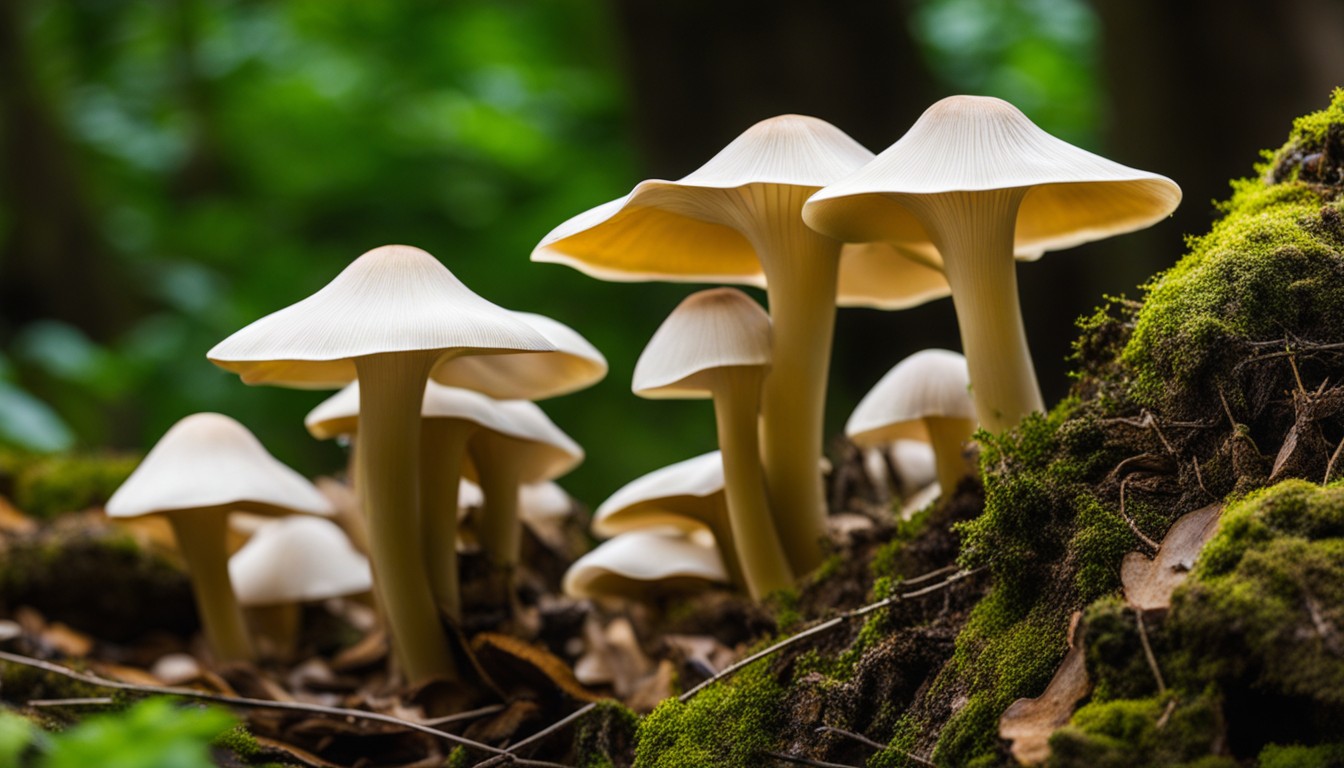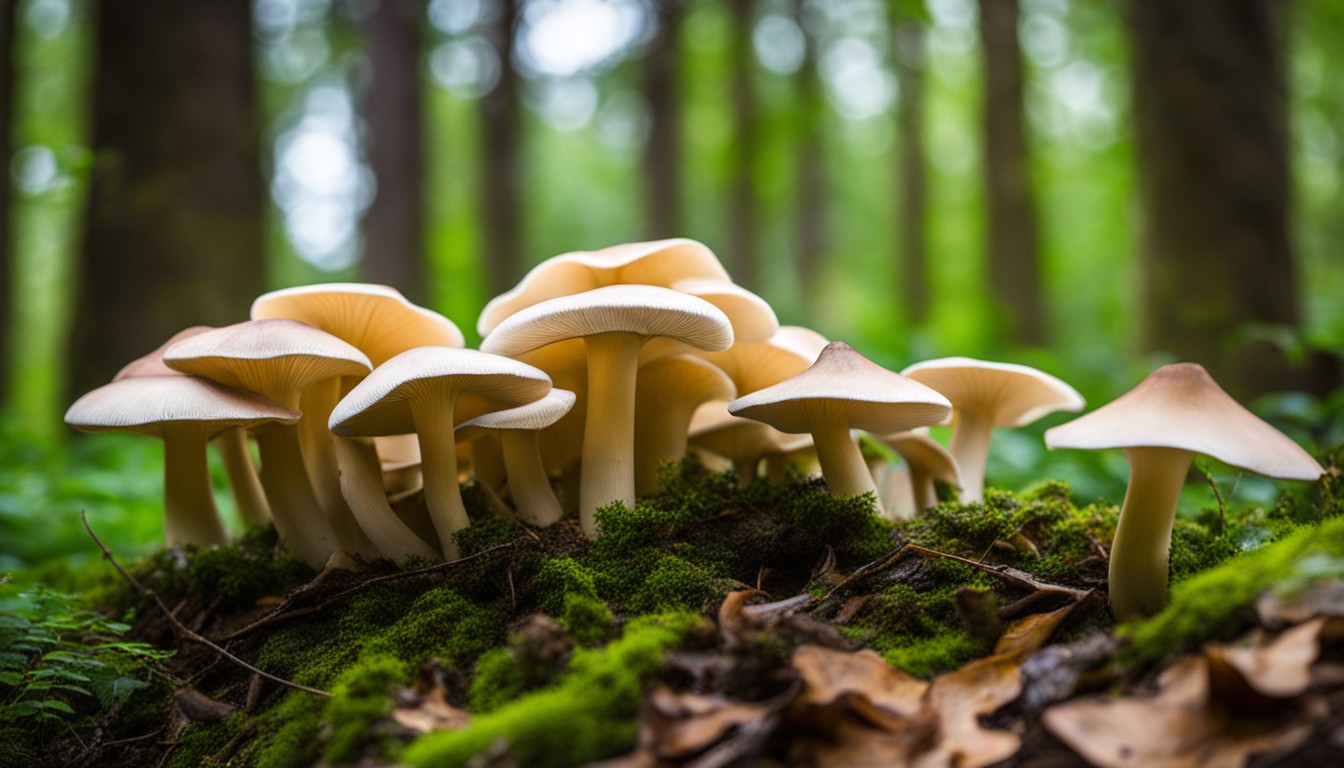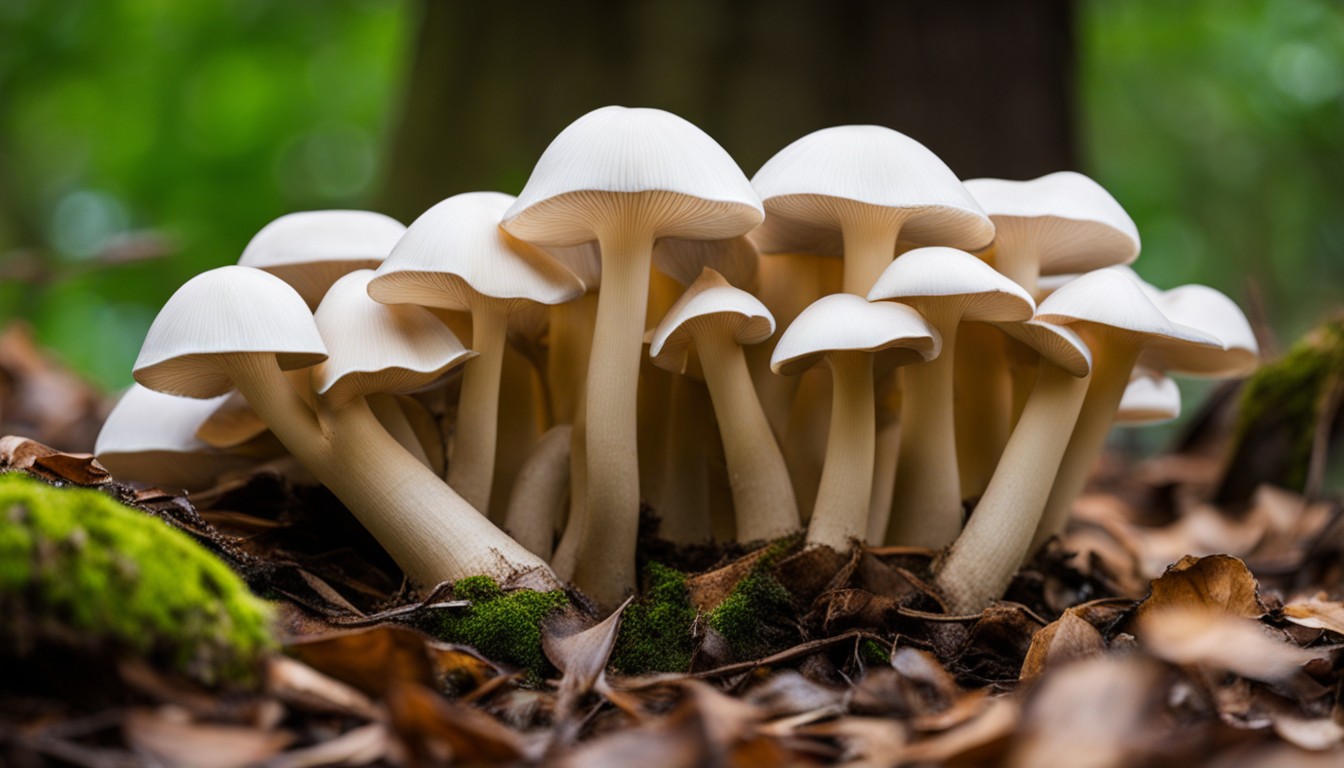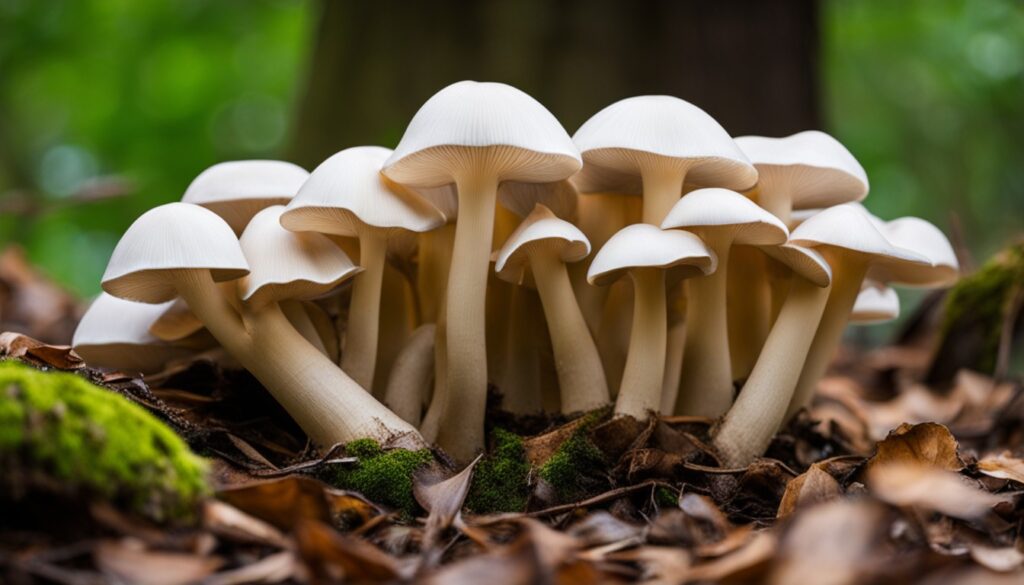Mushrooms of Cascadia: Exploring the Fungal Wonders in the Pacific Northwest is an in-depth exploration of the diverse and fascinating world of mushrooms in the Cascadia region. From the towering Douglas firs to the lush moss-covered forest floors, Cascadia is a haven for mushroom enthusiasts and nature lovers alike. This article delves into the identification, ecology, and culinary uses of various mushroom species found in the region, providing valuable insights for both novice and experienced mushroom hunters. Join us on this enchanting journey as we uncover the hidden treasures of Cascadia’s mushroom kingdom. Discover how mushrooms serve as crucial players in ecosystems, facilitating nutrient cycling and symbiotic relationships with trees and other organisms. We’ll also discuss the medicinal properties of certain mushrooms and their historical use by indigenous peoples. Whether you’re a foraging enthusiast, a nature photographer, or simply curious about the natural wonders of the Pacific Northwest, this article will inspire awe and ignite your passion for the captivating world of mushrooms in Cascadia.
Mushrooms in Cascadia: An Introduction
Cascadia, a region blessed with lush forests, presents a teeming tapestry of fungal wonders, illuminating our understanding of mycology. Each mushroom species unravels a unique tale of biodiversity and ecological harmony.
Beneath the surface of Cascadia lie secret networks of mycelia – fungal threads that interweave with the region’s flora. This underfoot world underscores the mushrooms’ intricate, ubiquitous role in our majestic Pacific Northwest ecosystems.
What is Cascadia?
Cascadia, from a geo-biological perspective, is a bioregion in the Pacific Northwest of North America. It encompasses parts of Alaska, British Columbia, Washington, Oregon, and California. This region, distinguished by common geographic and ecological characteristics, shares a unique, rich fungal ecosystem.
Cascadia, aka the Pacific Northwest, is celebrated as a ‘fungi haven’ owing to its inherent geographical diversity fostering a rich and varied fungal ecosystem.
Intrigue lies in Cascadia’s definition as it transcends political boundaries. Its delineation focuses more on shared ecologies, geographies, and social and cultural traits. The area truly represents nature’s realm, a ‘place’ defined by its biota.
The Pacific Northwest, synonymous with Cascadia, is a region known for its diverse landscapes. It includes mountains, coastal areas, forests, and high deserts, creating a captivating range of habitats for the fungal kingdom.
Similar to the bioregion’s geographic and ecological diversity, its fungal biodiversity mirrors it. This intrinsic diversity in fungal biomatter commends and amplifies the Pacific Northwest, Cascadia, as a ‘fungi haven’–a paradise for mycologists and nature enthusiasts alike.
Importance of Mushrooms in Cascadia
The significance of mushrooms in the Cascadian biosphere extends beyond their simple biological presence. They play integral roles in the maintenance of forest ecosystems, effectively enhancing soil fertility and facilitating plant growth.
In the pulsating heart of nature’s cyclical processes, Cascadia’s mushrooms function as the great recyclers. They decompose organic materials, breaking them down into elements absorbed by surrounding flora, essentially ensuring the life stream keeps flowing.
It is no exaggeration to affirm the proliferation of Cascadia’s lush forests is tightly entwined with its fungi inhabitants. The mycelium networks formed by mushrooms serve as a kind of natural internet facilitating the exchange of nutrients among trees.
An inconspicuous but essential player, Cascadian mushrooms are instrumental in preserving the biodiversity of their habitats. Contributing to the survival and health of an array of fauna, they create intricate food webs, contributing to overall ecosystem stability.
Promoting sustainability through their utility, many of these mushrooms have found their way into traditional medicine and cuisine, showcasing Cascadia’s rich culture. Thus, these fungal organisms not only contribute to ecological balance but also to society’s sustenance and well-being.
Ecological Role of Mushrooms in Cascadia
Mushrooms, serving as primary decomposers, play an instrumental role in the Cascadian Forest’s cycle of life. They metabolize dead organic matter, turning it into fertile soil capable of nurturing the forest’s next generation.
Moreover, these fungal wonders don’t just break down the old; they actively promote richness in biodiversity. By creating diverse nutrient-rich substrates and maintaining a balance within the ecosystem, mushrooms have become the unseen heroes of Cascadia’s rich and varied landscapes.
Popular Mushroom Varieties in Cascadia

Cascadia sings with songs of indigenous mushroom species that brighten its landscapes. The variety we find here, from the dulcet tones of Chanterelle and Morel to the deep symphony of Porcini and Matsutake, creates a melodious harmony of fungal diversity.
Cascadian signature fungi, including Chanterelle, Morel, Porcini, and Matsutake, are highly sought after. Each of these prestigious mushroom species lends a unique flavor, texture, and appeal to the mushroom connoisseur’s palate.
Chanterelle Mushrooms
Chanterelles, known for their delicate flavor and vibrant golden hue, can be found peppered throughout the lush landscapes of Cascadia. Sought out for their unique peppery flavor, they remain a favorite amongst gourmet chefs and culinary ardent throughout the Pacific Northwest.
- Chanterelles add an exceptional touch to a variety of dishes, letting their subtle taste and texture add a rich, earthy aroma to pastas, risottos, and stews.
- The ideal time to hunt for Chanterelles in Cascadia is in the fall, during the damp and cool weather conditions they favor.
- The proper identification of Chanterelles requires a keen eye, as they often resemble false and potentially poisonous mushrooms.
- When harvesting Chanterelles, it’s advised to cut the stem at ground level rather than pulling up the entire mushroom to promote regrowth.
- Compliance with local guidelines and sustainable foraging practices is crucial while hunting for these beautiful, golden treasures.
Morel Mushrooms
Known for their peculiar appearance, Morel mushrooms are among the most prized fungi in Cascadia, with an unmistakable honeycomb-like structure and a distinctive earthy, nutty flavor. Understanding their unique life cycle and careful identification can lead to successful and safe foraging.
- Deciphering the characteristic capped structure and pitted surface to accurately identify Morels
- Learning about the Morel’s fascinating life cycle, including its symbiotic relationship with certain trees
- Undertaking careful foraging by distinguishing Morels from similar poisonous species
- Insights into the best habitat conditions for Morel growth: primarily in burnt, logged or disturbed areas
- Understanding seasonal patterns of Morels – typically spring to early summer
Porcini Mushrooms
Porcini mushrooms, revered in the culinary world as the ‘Deli of the Forest’, play an integral role in the traditional cuisine of Cascadia. Known for their bold, distinct flavors, and unique physical features, they truly encapsulate the essence of the lush, diverse Pacific Northwest.
- – Signature earthy and nutty flavor with a smooth, creamy texture adds complexity to Cascadian dishes.
- – Recognized by their large, brown cap and white, stout stem – a distinguishing feature unique to Porcini mushrooms.
- – Versatility in cooking: equally delicious whether grilled, sautéed, dried, or used in soups and sauces.
- – Foraging tip: In the Pacific Northwest, they are typically found in coniferous woods during late spring to early autumn.
Matsutake Mushrooms
Matsutake, a highly valued variety of mushroom in Cascadia, adds an enchanting fragrance and unique flavor to many dishes. The intricate relationship between Matsutake mushrooms and pine trees in their natural habitats also reinforces the importance of sustainable foraging and conservation efforts.
- Matsutake, known as the ‘pine mushroom,’ draws its distinctive spice-like scent from the pine roots it grows near.
- Due to its symbiotic relationship with specific tree species, Matsutake growth reflects the health of the forest ecosystem.
- Matsutake’s cultural significance spans across many Asian cuisines, especially in Japan.
- Overharvesting and habitat disruption pose a significant challenge to the conservation of Matsutake.
- The scarcity and high market value of Matsutake has led to it being referred to as the ‘white gold’ of mushrooms.
- Finding a Matsutake requires keen eyes as it typically grows hidden under the forest floor litter.
Unique Mushroom Habitats in Cascadia

Cascadia’s diverse habitats offer a rich microcosm for mushroom growth, from coastal rainforests to alpine meadows, each hosting a distinct array of fungal species. These microclimates, each with its unique environmental attributes, provides a fertile canvas for enhancing our understanding of mushroom ecology.
A cornucopia of fungal species thrive in the Pacific Northwest. Pull back the green curtains of ancient forests or peer into the darker corners of moss-draped woods; you will find a myriad of mushrooms, testament to Cascadia’s rich and varied mycological landscapes.
Coastal Rainforests and Mushrooms
Cascadia’s coastal rainforests, richly moist and dense, are prolific breeding grounds for diverse kinds of fungi. The unique coastal conditions significantly influence the mushroom species that thrive within these ecosystems.
- The salubrious nature of the coastal environment aids mycorrhizal relationships, fostering a robust fungal network.
- High rainfall, prevalent in coastal areas, contribute to the optimal conditions for fungal growth.
- Undergrowth and decaying plant matter in these moist ecosystems offer nutritious substrates for mushroom species.
- Coastal conditions in Cascadia allow the proliferation of mushroom species like the Seaside Webcap, influenced heavily by its proximity to the sea.
Alpine Meadows and Mushroom Varieties
Located at high altitudes, Cascadia’s alpine meadows are a fertile home for a vast array of mushrooms. Unique fungi found in this environment, such as the fire-loving morels, are equipped to withstand harsh conditions and play a vital role within these ecosystems.
Cascadia’s alpine meadows offer a unique environment for fungi, exhibiting a concentration of mushroom varieties not typically found in other locales. Among these are the ethereal snow mushrooms, sprouting from the cold ground even in winter months, demonstrating the resilience of fungi.
The landscape of alpine meadows in Cascadia and the diversity of mushrooms found there are closely interlinked. The combination of the region’s high altitudes, unusual soil composition, temperature fluctuation, and climatic conditions fosters the growth of diverse mushroom species.
In these meadows, mushroom species exhibit fascinating adaptations to cope with significant environmental stress. Variation in snowmelt timing, temperature extremes, and nutrient availability ultimately shapes the very existence of these fungi, showcasing the dynamic nature of mushroom evolution in alpine habitats.
Old-Growth Forests: Hidden Mushroom Treasures
Cascadia’s ancient woodlands are a verdant treasure trove for a variety of fungi. The lush, moist forest floor, enriched by decaying organic matter, provides the perfect breeding ground for these lifeforms.
In the intricate ecosystem of these old-growth forests, the vast diversity of fungi play a vital role. From breaking down dead plant material to facilitating the growth of trees, mushrooms perpetuate the cycle of life, cementing their invaluable status.
Mushroom Foraging in Cascadia
Cascadia’s mushroom foraging offers mystical encounters with Earth’s natural wonder. Safe and sustainable practices, backed by knowledge and respect for biodiversity, ensure we protect this fungal treasure.
Foraging in Cascadia operates on the rule of do’s and don’ts. Understanding the local laws and being able to correctly identify edible and non-edible mushrooms safeguards both forager and forest.
Safety Precautions for Mushroom Foraging
Navigating the risky terrains of Cascadia requires certain safety protocols. One must be adept at identifying toxic mushroom species, and carrying a dedicated mushroom guidebook is highly recommended. Besides, keeping a close eye on weather conditions and always notifying someone about your foraging location and return time ensures safety.
In terms of ensuring a safe foraging experience, comfort should come first. Wearing proper dressings like long-sleeved shirts, pants, boots, and gloves protect against thorns and insects. Also, equipment like a knife, containers, brush, and compass should be on your foraging list. Remember, the thrill of the hunt should never overshadow personal safety.
Best Times for Mushroom Foraging
The myriad of mushroom varieties in Cascadia marks their distinctive seasons. Spring invites the Morel mushrooms, while autumn brings plentiful Chanterelles. Those interested in Porcinis and Matsutakes should persue their foraging excursions mid-summer through fall.
Timing is crucial for the success of a mushroom forage. The Pacific Northwest’s damp and dewy conditions post rainfall, coupled with mild temperatures, provide optimal mushroom growth, offering a rewarding forage experience to both novice and adept foragers.
Best Practices for Sustainable Foraging
Embracing eco-friendly foraging in Cascadia entails adhering to principles of sustainability. Taking only mature mushrooms, leaving young ones to spore, and ensuring not to disturb the ground is paramount.
In the Pacific Northwest, the Leave No Trace practice is crucial for sustainable mushroom harvesting. Foragers are urged to tread lightly, taking care not to harm the surrounding environment or deplete mushroom populations excessively.
Rules and Regulations for Mushroom Foraging
Understanding the regulations surrounding mushroom foraging in Cascadia is crucial to stay legal and ensure sustainable practices. Certain species may be protected, and harvesting them might be illegal.
In Cascadia, most public lands permit mushroom foraging for personal use, but commercial raking is prohibited. Each state or national forest within Cascadia has its set rules, some requiring permits.
The regulatory landscape of Cascadian mycology is complex but navigable. Foragers must be keenly aware of permissions required, restrictions in place, and respect private property boundaries.
Always cross-check with local rangers, consult updated guidelines of the local forestry department, or use reliable online platforms dedicated to mycology laws in Cascadia to stay informed and compliant.
Mushroom Events and Festivals in Cascadia

Mark your calendar for Cascadia’s annual Mycophile celebrations! Noteworthy events include mushroom forays, guided nature walks, and expert workshops catering to both beginners and experienced foragers.
The Pacific Northwest’s fungal season is dotted with festivals poised for the picking. These jubilant gatherings place emphasis on sustainability and community, celebrating the diverse fungal wonders in an atmosphere of camaraderie and excitement.
Mushroom Forays and Workshops
Mushroom forays and workshops in the Pacific Northwest offer an opportunity to learn from seasoned experts. They provide practical lessons in identifying, picking, and even cooking with Cascadia’s diverse mushroom species.
Engaging in these events not only enriches one’s knowledge of mycology but also heightens appreciation for the region’s biodiverse flora and fauna. It’s here, during mushroom forays, that one truly lives the adage of ‘learning by doing’.
These workshops act as a starting point for novices, providing them with foundational knowledge. For the more experienced, they offer a chance to exchange insights and forge meaningful relationships with fellow mycophiles.
In pursuit of Cascadia’s fungal wonders, one is often amazed by the bounty of exciting discoveries during the forays. This passion for exploration, coupled with the thrill of unearthing a rare or elusive mushroom, keeps enthusiasts returning year after year.
Annual Mushroom Festivals
Cascadia’s annual mushroom festivals offer a delightful showcase of the region’s mycological diversity. Attendees can engage in activities that reveal the fascinating array of fungi, from smallest mycorrhizal species to towering toadstools.
The gastronomical side of these festivals provides a unique opportunity to feast on fungi. Participants can experience the rich, earthy tastes and textures of wild mushrooms, gathered from Cascadia’s forests and transformed into delicious culinary creations by local chefs.
Frequently Asked Questions (FAQ)
What makes Cascadia a unique region for mushrooms?
Cascadia’s temperate rainforests, diverse tree species, and moist climate provide the ideal conditions for a rich variety of mushroom species to thrive. The region’s abundance of old-growth forests and undisturbed habitats create a haven for both common and rare mushroom species. With over 3,000 known mushroom species, Cascadia is an exceptional place for mushroom enthusiasts and researchers to explore.
How can I identify mushrooms in Cascadia?
Identifying mushrooms requires a combination of visual observation, spore prints, and studying key features such as the cap shape, gills, stem, and any distinctive characteristics. It is advisable to use reliable field guides, attend workshops, or join local mycological societies to enhance your identification skills. Engaging in hands-on learning experiences and seeking guidance from experienced mushroom experts can greatly contribute to your knowledge and confidence in mushroom identification.
Are there any poisonous mushrooms in Cascadia?
Yes, Cascadia is home to several toxic mushroom species. It is crucial to exercise caution and consult reliable field guides or experts before consuming or handling wild mushrooms. Learning to differentiate between edible and poisonous species is essential for safe foraging. It is recommended to start with easily identifiable edible mushrooms and gradually expand your knowledge as you gain more experience in mushroom identification.
Can I forage for mushrooms in Cascadia?
Foraging mushrooms in Cascadia can be a rewarding activity. However, it is important to obtain the necessary permits, follow regulations, and have a thorough knowledge of edible species to ensure safety and sustainability. Adhering to guidelines and respecting the environment helps preserve mushroom populations for future generations. It is also recommended to practice responsible foraging by only harvesting a portion of mushrooms, leaving some behind to allow for spore dispersal and the continuation of the mushroom life cycle.
Are there any rare or endangered mushroom species in Cascadia?
Yes, there are several rare or endangered mushroom species in Cascadia. Habitat loss, climate change, and over-harvesting pose threats to their survival. It is essential to respect protected areas, avoid disturbing sensitive habitats, and report any sightings to local authorities or conservation organizations for proper documentation and conservation efforts. By actively participating in mushroom conservation initiatives, you can contribute to the preservation of these unique fungal species.
What are some popular culinary mushrooms in Cascadia?
Cascadia boasts a range of delectable culinary mushrooms, including the prized chanterelles, morels, porcini, and oyster mushrooms, which are highly sought after by chefs and mushroom enthusiasts alike. These gourmet mushrooms add unique flavors and textures to a variety of dishes. Exploring local farmers’ markets, specialty food stores, and culinary events can provide opportunities to savor and appreciate the culinary delights offered by Cascadia’s mushroom kingdom.
Can mushrooms in Cascadia have medicinal properties?
Yes, certain mushroom species found in Cascadia, such as the reishi, turkey tail, and lion’s mane, have been recognized for their potential medicinal properties, including immune-boosting and antioxidant effects. Traditional medicine and modern research have shed light on the therapeutic potential of these mushrooms. Incorporating these medicinal mushrooms into your diet or exploring their use in natural remedies can be a fascinating journey into the intersection of food, health, and traditional healing practices.
How can I learn more about mushrooms in Cascadia?
There are various resources available, including field guides, workshops, and online communities dedicated to mushroom identification, foraging, and appreciation of fungi in Cascadia. Joining local mycological societies can also provide valuable learning opportunities, as experienced enthusiasts and scientists share their knowledge and passion for mushrooms. Exploring the diverse ecosystems of Cascadia and immersing oneself in the natural environment is another great way to deepen your understanding of mushrooms in this captivating region. By participating in guided hikes, attending lectures, and engaging in hands-on activities, you can expand your knowledge of mushroom ecology, biodiversity, and their role in the larger ecosystem.
Conclusion – Celebrating the Fungal Diversity of Cascadia
Cascadia’s biodiversity is beautifully punctuated with an astounding array of mushrooms. This rich mycological heritage, nurtured by unique habitats, represents a vital layer in Cascadia’s life tapestry.
- Emphasize conservation and education efforts to preserve Cascadia’s unique fungal diversity
- Promote ecotourism focusing on the region’s mycological wonders
- Leverage the essential role of mushrooms in maintaining the health and balance of Cascadia’s ecosystems
- Preserve the tradition of mushroom foraging while ensuring sustainability
- Celebrate the amazing variety of mushrooms through local events and fairs

